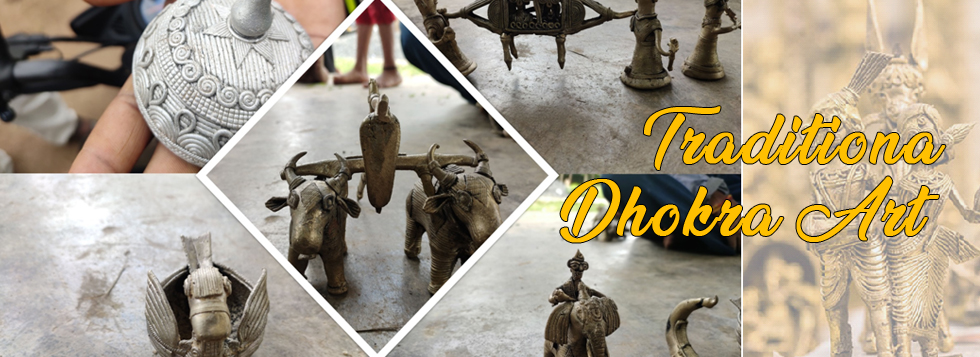
Regeneration of Traditional Dhokra Art.
An Effort To Make Our Diminishing Traditional Tribal Art and Craft Global To Add To The Mission of AtmaNirbhar Bharat.
YUVA – Making Efforts To Promote Dhokra From Local To Global
Dhokra (also spelt as Dokra) is non-ferrous metal casting technique using the lost-wax casting technique. One of the earliest known lost wax art effects is the dancing girl of Mohenjo-daro. The product of Dhokra artisans are in great demand in domestic and foreign markets because of primitive simplicity, enchanting folk motifs and forceful form. Dhokra horses, elephants, peacocks, owls, religious images, measuring bowls, lamp caskets etc. are highly appreciated.
The Dhokra people are settled over a vast tract in the mineral-rich central Indian tribal belt covering the modern regions of Orissa (mainly people from the aboriginal caste called Sithulias), Jharkhand, Chattisgarh and parts of Andhra Pradesh. The Dhokra motifs have been inspired by the folk culture. Dhokra crafts are created from Bell metal, brass or bronze. The proportion of the metal in the alloys, constitution of the mould, firing techniques etc. vary from one region to other. The material used is not pure brass/bronze, but contains scraps of other metals which give it the typical antique look.
History
The Dhokra metal casting technique uses the Lost-wax technique that was probably used by the Mohenjo-daro craftsmen to cast the bronze figurine of a dancing girl some 4500 years ago. This type of metal casting has been used in India for over 4000 years and is still being used. The lost-wax technique called “Cire-Perdue” in French is a metallurgical art form that is one of the oldest and at the same time most advanced too. It has been a favourite of many modern-day sculptors and for the last 100 years been employed in Dentistry and Industrial manufacturing too.
Classification of Dhokra Works and Generalization
Today Dhokra craft is the number one choice among Indian handicrafts and brassware. The chief reason why among all other Indian handicrafts, Dhokraart or Dhokra craft is so much in demand is that ’No two pieces of Dhokra Craft, are alike. Each and every single piece of Dhokra craft is unique. It is difficult to believe but every piece of Dhokra craft, even the most ordinary pieces of humble everyday use wares are created with a lot of care, love, creativity and highest level of perfection. Dhokra craft has made a secure place for itself both in domestic markets as well as in foreign countries like France, Italy, USA and UK. Because of its enthralling folk motifs, primeval plainness, artistic sagacity, talent, skilled craftsmanship of the highest order and intuitive and instinctive sense of creativity and innovation of course the design aesthetics and pattern of these Dhokra metal craft pieces have undergone 4500 years of evolution and perfection - a trait that is easily noticeable and which has caught the attention of discerning art collectors. In fact these art pieces are highlycoveted in International art market and brassware handicraft fairs. It is also coveted because of its powerful form, charming folk motifs and primitive simplicity, which lets one peek a glimpse into the indigenous folk culture of India. Currently one can find several families of Dhokra craftsmen scattered in West Bengal, Jharkhand, Bihar, Orissa, and Madhya Pradesh etc, where their main source of livelihood is making and selling Dhokra art pieces in local markets also known as haats. In Jharkhand the artisans use Bitumin or coal tar instead of Bees wax in their metal casting, unlike the artisans of West Bengal, Orissa, Madhya Pradesh etc. In almost all the other states Dhokra art has been revived due to Government and Non-Government Patronage but the Dhokra Craft is dying a slow death in Jharkhand and Bihar.
It is unfortunate that this beautiful artwork is facing an obvious decline. The steady increase in the cost of raw material makes the end products way too expensive to attract enough buyers. As a result, artisans have been showing less interest in producing such master works. Lack of inspiration, encouragement and knowledge of new designs as well as the inability to adapt to modernization have also contributed to the decline of this artwork.
YUVA has been exploring Possible Partnership for regeneration of this diminishing art and craft in Jharkhand State.
